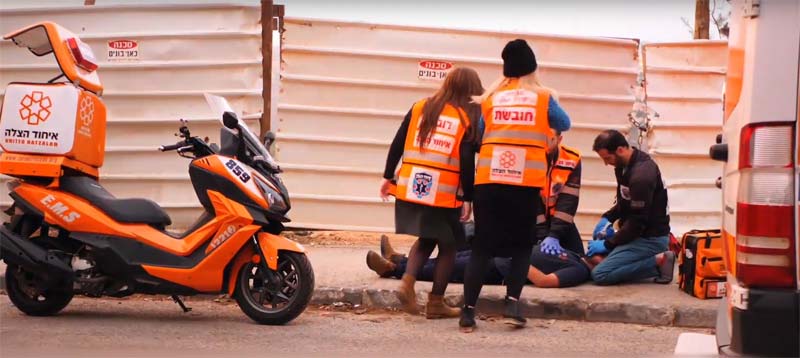
On the afternoon of January 2, Yehonathan "Yoni" Guigue received an alert on his cell phone: there was a person lying on the ground, feeling unwell, a few blocks away. Within 90 seconds of receiving the notification, Yoni was on the scene. He quickly ascertained that the man before him — unconscious, without a pulse, and not breathing — was in cardiac arrest. Yoni enlisted a police officer to help with chest compressions and alerted Jersey City Emergency Medical Services (EMS) to the life-threatening nature of the incident. Using defibrillation, Yoni saved the patient's life, getting a pulse back just before the paramedics arrived.
Yoni is one of more than 100 volunteers equipped and trained by United Rescue, a pre-ambulance emergency-care service that uses a smartphone app to alert its volunteers when they're near the scene of a health-related 911 call.
[EDITOR'S NOTE: The group was founded by an ultra-Orthodox Jew in Jerusalem.]
Since Jersey City Mayor Steven Fulop partnered with Eli Beer and Mark Gerson of United Rescue to launch the service in 2015, its volunteers have responded to roughly 100 calls per week. With an average response time of two and a half minutes, United Rescue volunteers arrive at least one minute before an ambulance in over 50 percent of calls — a difference, as Yoni's story suggests, that saves lives. It's time that Jersey City's much bigger neighbor across the Hudson take notice.
With only 250,000 residents, Jersey City is much smaller than New York City. But size notwithstanding, both cities' EMS professionals share challenges: navigating high-rise buildings, high population densities, and traffic congestion. What's more, United Rescue is modeled on United Hatzalah in Israel, a country with a comparable population size to New York City's, where volunteers field more than 1,000 calls each day. Jersey City shows how the United Rescue approach could work nationwide. United Hatzalah, in turn, demonstrates that it scales — the same approach could enhance New York City's emergency medical services and save lives.
Backed by funding from foundations, corporations, and philanthropic contributions, United Rescue is a free service for partner cities, though a partnership requires city leaders to provide United Rescue with access to their 911 dispatch.
In Jersey City, United Rescue underwrites one additional dispatcher during high-volume periods, ensuring volunteer efficiency and supporting EMS resources. Dispatchers also screen calls to keep volunteers from unsafe scenes involving crimes like assault or domestic violence, to which EMS professionals are otherwise required to respond.
New volunteers receive extensive training at United Rescue's expense. In Jersey City, cohorts of no more than 20 recruits undergo more than 100 hours of training over the course of 11 weeks, a mixture of coursework, hands-on skills training, and in-field experience with EMTs, paramedics, dispatchers, and current United Rescue volunteers. Some volunteers are medical professionals themselves — doctors, nurses, paramedics, EMTs, or other medical technicians who, even off-duty, would prefer receiving an alert to help a neighbor than see an ambulance pull up after it is too late.
Once trained, volunteers receive a tactical backpack with much of the essential EMS equipment: an oxygen tank, gauze, ointment, shears, an automatic external defibrillator, and, as of 2016, naloxone nasal spray for opioid overdoses. The equipment, combined with the training, allows volunteers to treat patients before an ambulance arrives, making emergency care more effective. Since Jersey City volunteers began carrying naloxone, for example, United Rescue has helped 28 people overdosing on opioids.
Good Samaritan laws, adopted by states to encourage bystanders' assistance in an emergency, largely exempt volunteers from liability. In Jersey City, EMS professionals enjoy their working relationship with volunteers, who provide a valuable service to their community.
Nabil Hajo, a paramedic who responded to the cardiac arrest on January 2, said, "my partner went to see the patient and she found that he already had a pulse. So, the hard work was already done by United Rescue before we got there." In 2018, New York City paramedics' average response time to 911 calls — involving choking or cardiac arrest — increased by 24 seconds compared with the previous year. The Fire Department of New York, which oversees the city's EMS system, is working to reverse the slower EMS response times. But even if the city and FDNY optimized their response time, United Rescue volunteers can often arrive at emergency scenes sooner.
As New York works to improve the response times of its emergency medical professionals, it should conduct a borough- or neighborhood-wide pilot of United Rescue's program — testing whether the service effectively complements EMS, and planning to scale it up if it works.
If United Rescue can do for New York -- and other metropolitan cities -- what it has done on a smaller scale for Jersey City, it will save lives and promote the volunteerism that can strengthen communities across the nation.
Sign up for the daily JWR update. It's free. Just click here.
(COMMENT, BELOW)
Brandon Fuller is a research scholar and deputy director at the NYU Marron Institute of Urban Management. He wrote this for City Journal.


 Contact The Editor
Contact The Editor
 Articles By This Author
Articles By This Author